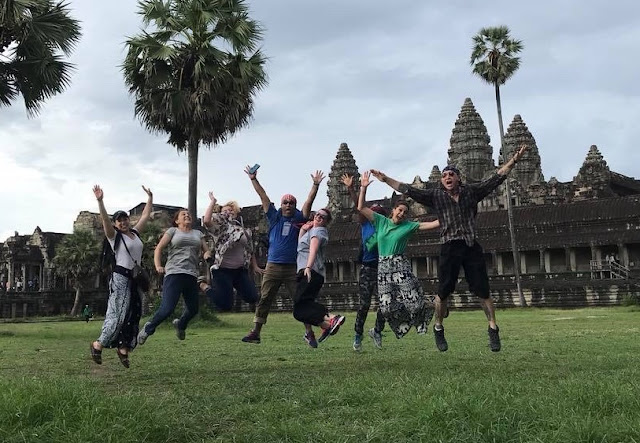On Sunday when the skilled workers had the day off, we visited three
sites from the Angkor Empire. This was the Empire that preceded modern-day Cambodia, from the 9th to the 15th century. After the capital was moved to Phnom Penh, these sites remained abandoned for four centuries and were overtaken by jungle before being rediscovered by French explorers. These awe-inspiring structures are now once again able to be viewed by visitors from around the globe.
Our first stop was the walled city of
Angkor Thom, the capital of the Angkor Empire. We crossed a moat via a causeway lined with giant stone carved figures, gods on the left side and demons on the right. I felt like I was on a movie set for an ancient saga. The gods and demons were characters from a famous Hindu epic, the
churning of the ocean of milk.
 |
| Carved gods "churning the sea of milk" along the causeway leading to Angkor Thom |
We entered through one of four enormous stone gates beneath a tower containing four enormous stone faces. "Enormous stone" describes nearly everything in Angkor Thom. Just as with the ancient pyramids, the labor required to bring the stones to the site and erect these structures was awe-inspiring. Our tour guide explained that the stones were pulled in by elephants and water buffalo, then lifted up using earthen ramps.
 |
| Gate to Angkor Thom. At the top are giant faces looking four directions. |
 |
The only elephant we saw at Angkor Thom was hauling tourists, not massive stones.
Cambodia does still have herds of wild elephants, but not in the districts we visited. |
The Buddhist faces on the gate tower right next to the Hindu gods and demons on the causeway illustrate the close relationship between Hinduism and Buddhism in Cambodia. Both religions are integral to Cambodia's history and current culture, and both came here from India. Every temple we visited had been converted from Hindu to Buddhist or Buddhist to Hindu, or both, at least once over the course of its history, as different kings came to power. Cambodians continue to honor both of these traditions.
At the center of the city is Bayon Temple, built as a Buddhist shrine in the year 1200. It has 54 towers, each of which features four stone faces like the ones on the entrance gate--216 faces in all!
 |
Bayon Temple
|
 |
| Nose to nose |
Next we visited the temple of
Ta Prohm. This temple is fascinating not just because Lara Croft: Tomb Raider was filmed there, but because many of the enormous trees that invaded the structure were left in place during the recovery and restoration. It is a place important not only to Buddhists and Hindus, tourists and Hollywood, but also to the jungle.
Finally, we visited Cambodia's most famous temple,
Angkor Wat. This massive, magnificent complex is the largest religious monument in the world. I can't even begin to describe the beauty and enormity of this place. At the center are five iconic stone towers, the tallest in the center, with four others surrounding it. We climbed to the top on steep, narrow, stone steps, and then the jungle spread out before us for miles. (Our tour guide mentioned several times that no building in Siem Reap is permitted to be taller than Angkor Wat, so this really is the highest point in the province.)
Really, I can't describe this experience. You'll have to go and see it for yourself.
 |
| Part of our crew--dwarfed by the size of this ancient swimming pool |
 |
| The central tower |
 |
| Statue of Buddha, draped with robe |
 |
| A view down from the peak |
 |
| Watching a storm approach from the top of the temple |


















No comments:
Post a Comment